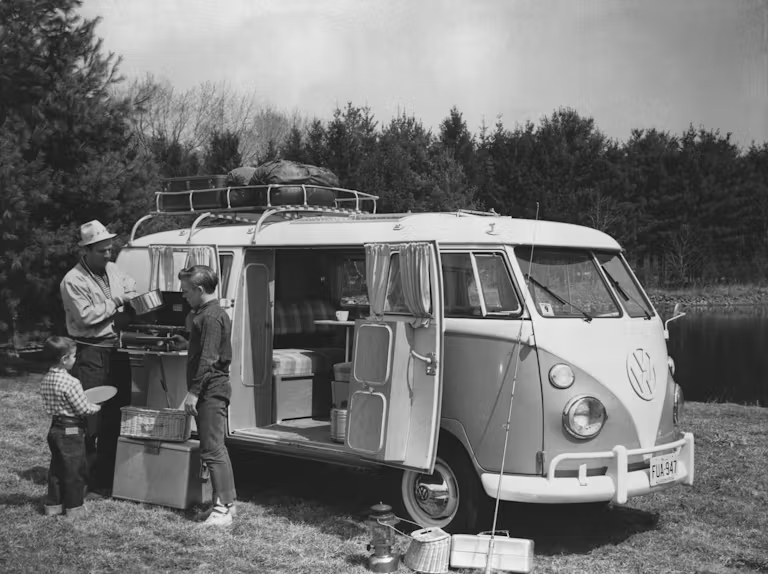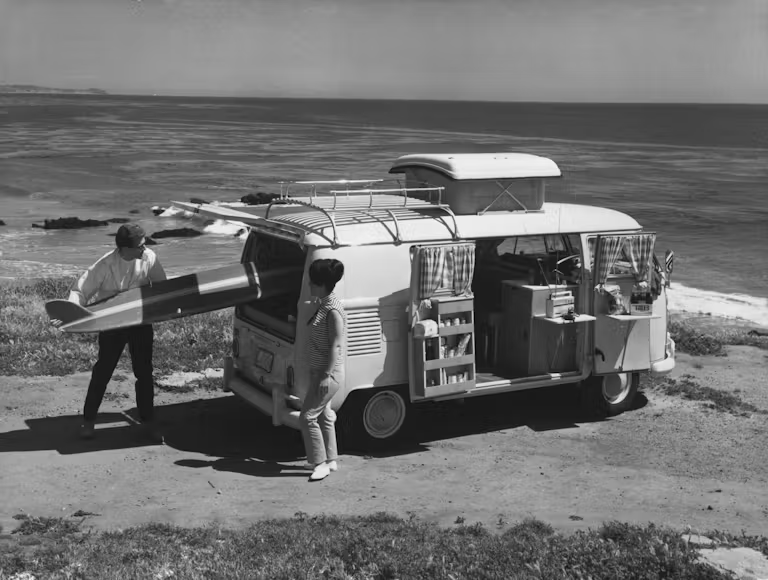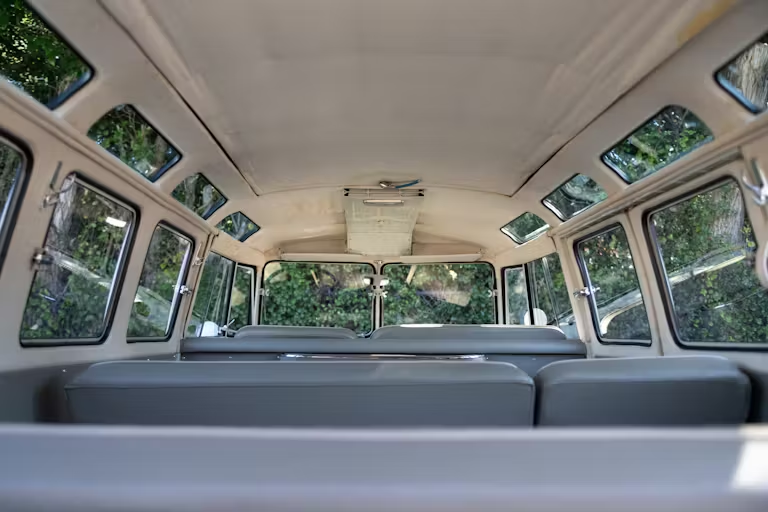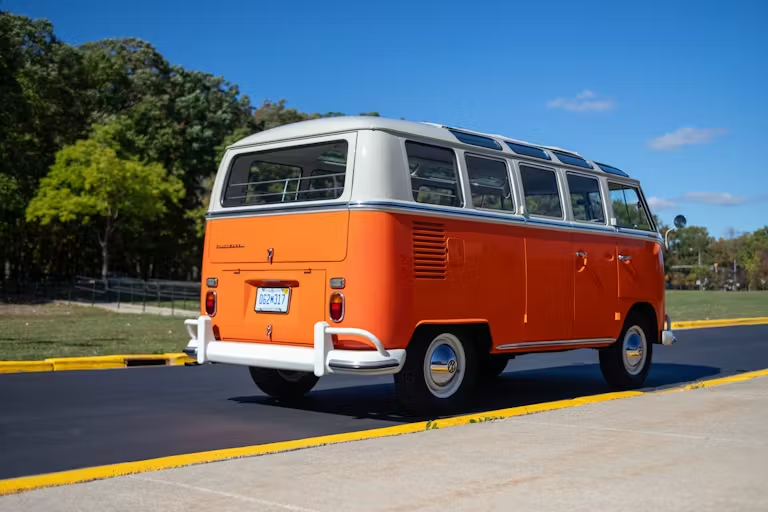As a child of the late ’90s, I associate the VW Bus with the first Cars movie. Specifically, with Fillmore, the pastel green VW Bus who champions “organic fuel” and is voiced by George Carlin. My family is one of those that enjoys quoting movie lines to each other, and Fillmore’s trademark moan is a favorite. “The oil company’s got a grip on the government!

They’re feeding us a bunch of lies, maaan.” With Fillmore, Pixar executed the perfect generational nod. My siblings and I get the reference to the 2006 movie (and the open-world, THQ game we played on our massive old Mac), and my parents get it because they were there when the Microbus became synonymous with pastels, paisley, weed, and rock ‘n’ roll.
What I didn’t know until recently, when I got the chance to drive a 21-window ‘67 Bus, was that these humble haulers have ascended to princely status in the collector-car world. Even as VW pauses production of the Microbus’ battery-powered successor due to weak demand, the original, cheerful Bus (1950–67) is only becoming more valuable.



Despite its association with camping, surfing, and music festivals, the Bus was born as a workhorse. The idea began with Ben Pon, the same Dutch businessman who brought the Beetle to the States. On a visit to the VW factory, he spotted some funky-looking flatbeds made from Beetle parts. The factory workers used these “plattenwagons,” as our Ronan Glon wrote, just like we’d use a forklift today. Pon was inspired. He sketched a small, squared-off bus and shared the idea with VW management. Less than three years later, the Volkswagen Type 2 “Transporter” entered production.

The basic Type 2 was an eleven-window panel van called the Kombi (it could seat passengers and haul cargo at the same time), with a two-piece windshield and a 25-hp flat-four engine. VW quickly added versions with more windows, then a two-tone model with pivoting side doors and a sunroof (the Samba, or Microbus DeLuxe in the States). VW advertised the Samba as the perfect vehicle in which to tour the Alps, foreshadowing the model’s close association with road trips (and very, very slow climbs up mountain grades). To Germany’s war-ravaged economy, the Transporters were lifesavers. Reliable and affordable to service, the air-cooled vans served as ambulances and police cars and mail trucks and work vehicles for plumbers and flower shops. To give you an idea of how popular these buses became, by October 2, 1962, VW had built one million of them. (For context, Ford reached one million Model Ts in about seven and a half years.)

This first-generation Bus forged its identity as a smiley-faced, spacious vehicle that was equally suited for work or adventure. The engine didn’t become more powerful until 1954, when VW blessed it with five more horsepower and began to offer the Bus with right-hand drive. In ‘55, the Transporter received an opening tailgate, a full-width dashboard, and hydraulic shock absorbers. In ‘56, it got its own factory, in Hanover. Four years later, the engine got another four horsepower (up to 34). That year (1959) was also when the transmission became far more user-friendly, thanks to synchromesh on gears two, three, and four. Turn signals appeared in 1960, replacing the mechanical semaphores, and engine output finally climbed above 40 hp in 1963, the same year that sliding doors became available. The electrical system was upgraded from six to twelve volts in 1966, when the split-window bus also got seatbelts.
The single biggest feature that impacts the value of a first-gen Bus is window count. Unfortunately for everyone’s sanity, the number of windows available in various trims changed throughout the seventeen-year run. The rule of thumb is “mo’ windows, mo’ money,” and there is a clear stratification between the 21- and 23-window buses and the rest (15, 13, and 11). The most valuable Type 2s belong to the first set and are the bechromed, relatively luxurious Sambas. With a condition #1 (best-in-the-world) value of $253,000, they are nearly twice as valuable as a 15-window van, the next most valuable configuration. Those are worth $114,000 in top condition. The 13-window Buses are right behind them, at $107,000. Six-figure values aren’t news; values for #1 condition Transporters surpassed the $100,000 mark about ten years ago.

Are they worth the scratch? Volkswagen of America recently gave us some time in its 1967 21-window DeLuxe to ponder that question. We were quickly surprised by how bus-like it is—perhaps we imagined that this stylish, Beetle-derived Transporter was as sprightly and as accommodating as it appeared, that it had somehow transcended its ladder chassis and 53-hp flat-four to become a speedy little squirt. You climb into the bus over the front axle, through a front door that’s hinged far forward, nearly in the van’s smiley face. The cabin is incredibly airy, thanks to all the windows. The impression of delicacy is reinforced by the two white bubbles protruding through what would normally be the firewall: They’re the buckets for the headlights. Reach for the top edge of the steering wheel or down to the gear shifter, and you’ll understand why everyone you’ve seen driving these vans hunches over the ginormous steering wheel and seems to rummage at their feet for the next gear. The steering wheel is that big—The New Yorker Magazine compared it to a hula hoop—and the gearshift really should be a foot taller. Depress the clutch and turn the delicate key in the ignition, and the flat-four clatters to life.

The steering column sprouts between the brake and the clutch. The Bus really is noisy to drive—it’s essentially a ladder-frame tin can with driver at one end and the noisemaker on the other. It’s jouncy, too. Despite the hydraulic shocks, you’re sitting right above the front axle, so if it moves, so do you. The Bus is also slow … but not scary slow. Climbing the Rockies or the Alps in this would be a white-knuckle experience for a modern driver, but around town, you’re never worried about scooting away from a stop sign or getting up to 35 or 40 mph in leisurely fashion. The 1493-cc flat-four makes torque quickly, and the (mostly) synchromesh transmission (first is straight-cut) is refreshingly familiar to operate. This bus doesn’t so much accelerate as groove at a gently increasing rate, cheerfully clattering all the way. And yes—strangers will roll down their windows to wave at you. School children will take pictures with iPads. It may be slow and noisy, but driving a Microbus really is that fun.

These Buses have been expensive for a while, and in the last five years, the Type 2 has continued to appreciate. Values for less-than-perfect examples are climbing faster than those for museum-quality ones: The average value for a first-gen Bus in #2 through #4 condition is up between 68 and 76%, while condition #1 values have increased 34%. This pattern suggests that the Transporter is maturing as a collector vehicle: As a model becomes more and more desirable, buyers are increasingly willing to pay for (or are restricted to) lesser-quality examples. You know the saying about the rising tide …

Quote volume, which we use to measure interest in a model, is up slightly for the original Transporter—9% in five years. The people who are interested in these Buses are the same as they were two years ago: 70% of quotes come from Gen X (who grew up with or in these vehicles) and younger. These generations make up 64% of the entire collector-car market, meaning that the Microbus attracts a slightly younger crowd than usual. It also attracts a disproportionately West Coast demographic: 34% of all the Type 2s we insure are in California. That number drops to about 24% when you adjust for the fact that California has a lot of collector vehicles compared to other states, but the trend remains: Other states in the top five include Washington and Oregon. We insure the fewest Buses in Texas, Pennsylvania, Michigan, New York, and Ontario (though we have it on good authority that these Buses are excellent in the snow).
They may be slow and noisy, but the first-gen Microbus is just as lovable as ever, and more valuable because of it.
Report by Grace Jarvis
find more news here.










